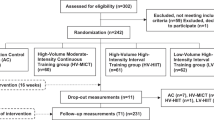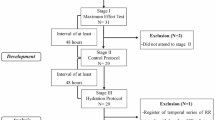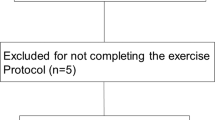Abstract
OBJECTIVE: The purposes of this study were to examine a new method to determine exercise intensity for obese people based on the cardiac vagal activity and to determine the effect of this approach on myocardial stress.
SUBJECTS: Forty-three middle aged obese female volunteers (age 43.7±6.5 y; height 1.56±0.05 m; body mass 66.5±9.3 kg; body mass index 27.3±2.8 kg m2; percentage body fat 40.7±5.9%).
MEASUREMENT: In the first experiment, 43 subjects performed a ramp exercise test on a bicycle ergometer with measurement of ECG and gas exchange parameters. In the second experiment, 11 subjects performed 45 min of constant walking exercise on a treadmill at a level corresponding to exercise intensity determined by vagal activity obtained from a ramp bicycle test. Blood pressure, endothelin 1 (ET-1), catecholamine, atrial natriuretic peptide (ANP), and brain natriuretic peptide (BNP) were measured before and after exercise.
RESULTS: The heart rate variability power decreased with increasing work rate, and changed little after reaching individual-specific work rate. We presumed that vagal activity disappeared at this point and that the heart rate at this exercise intensity was determined as the vagal activity threshold (TVA). The results showed a significant positive correlation (r=0.742, P<0.0001) between TVA and ventilatory threshold (VT) heart rates, although the mean heart rate of TVA (114.3±8.5 beats/min) was significantly lower (P<0.001) than that at VT (119.0±11.7), suggesting the cardiac vagal withdrawal occurred prior to the onset of lactate acidosis (lactic acid accumulation). Furthermore, exercise intervention experiment at TVA indicated that ET-1, catecholamine and BNP levels were not significantly different before and after exercise. However, ANP levels increased significantly after exercise (pre-exercise 18.6±5.38 vs post-exercise 44.0±24.87 pg/ml, P<0.001), which in turn brought about a significant post-exercise reduction in the blood pressure (SBP 117.6±13.7 vs 110.5±7.4 mmHg, P<0.05; DBP 78.6±6.7 vs 73.5±6.6 mmHg, P<0.01).
CONCLUSION: Our data suggest that it is possible to determine the exercise intensity (TVA) on the basis of cardiac vagal response. These results also suggest that exercise at TVA level is a safe exercise intensity in the light of cardiac stress, and that TVA may be recommended for obese people who might possess lower cardiac sympatho-vagal activity.
This is a preview of subscription content, access via your institution
Access options
Subscribe to this journal
Receive 12 print issues and online access
$259.00 per year
only $21.58 per issue
Buy this article
- Purchase on Springer Link
- Instant access to full article PDF
Prices may be subject to local taxes which are calculated during checkout



Similar content being viewed by others
References
Bray GA . Complications of obesity Ann Intern Med 1985 103: 1052–1062.
Kissebah AH, Freedman DS, Peiris AN . Health risk of obesity Med Clin N Am 1989 73: 111–138.
Manson JE, Willett WC, Stampfer MJ . Body weight and mortality among women New Engl J Med 1995 333: 677–685.
Ducimetiere P, Richard J, Cambien F . The pattern of subcutaneous fat distribution in middle-aged men and the risk of coronary heart disease: the Paris prospective study Int J Obes 1986 10: 229–240.
Larson BK, Svardsudd L, Welin L, Wilhemsen L, Bjorntorp P, Tibblin G . Abdominal adipose tissue distribution, obesity, and risk of cardiovascular disease and death: 13 year follow-up of participants in the study of men born in 1913 Br J Med 1984 288: 1401–1404.
American College of Sports Medicine. Guidelines for Exercise Testing and Prescription 5th edn Lea and Febiger: Philadelphia, PA 1995 pp 93–119.
American College of Sports Medicine. The recommended quantity and quality of exercise for developing and maintaining cardiorespiratory and muscular fitness in healthy adults Med Sci Sports Exerc 1990 22: 265–274.
Arai Y, Saul JP, Albecht P, Hartly LH, Lilly LS, Cohen RJ, Colucci WS . Modulation of cardiac autonomic activity during and immediately after exercise Am J Physiol 1989 256: H132–H141.
Dixon EM, Kamath MV, McCartney N, Fallen EL . Neutral regulation of heart rate variability in endurance athletes and sedentary controls Cardiovas Res 1992 26: 713–719.
Kleiger RE, Miller JP, Bigger JT Jr, Moss AJ . Decreased heart rate variability and its association with increased mortality after acute myocardial infarction Am J Cardiol 1987 59: 256–262.
Billman GE, Hoskins RS . Time-series analysis of heart rate variability during submaximal exercise: evidence for reduced cardiac vagal tone in animals susceptible to ventricular fibrillation Circulation 1989 80: 874–880.
Collins MN, Billman GH . Autonomic response to coronary occlusion in animals susceptible to ventricular fibrillation Am J Physiol 1989 257: H1886–H1894.
Petretta M, Bonaduce D, DeFilippo E, Mureddu GF, Scalfi L, Marciano F, Bianchi V, Salemme L, DeSimone G, Contaldo F . Assessment of cardiac autonomic control by heart period variability in patients with early-onset familial obesity Eur J Clin Invest 1995 25: 826–832.
Zahorska-Markiewicz B, Kuagowska E, Kvcio C, Mariusz K . Heart rate variability in obesity Int J Obes 1993 17: 21–23.
Akselrod S, Gordon D, Ubel FA, Shannon DC, Barger AC, Cohen RJ . Power spectrum analysis of heart rate fluctuation: a quantitative probe of beat-to-beat cardiovascular control Science 1981 213: 220–222.
Malliani A, Pagani M, Lombardi F, Cerutti S . Cardiovascular neural regulation explored in the frequency domain Circulation 1991 84: 482–492.
Pagani M, Lombardi F, Guzzetti S, Rimoldi O, Furlan R, Pizzinelli P, Sandrore G, Malfatto G, Dell'Orto S, Piccaluga E, Turiel M, Baselli G, Cerutti S, Malliani A . Power spectral analysis of heart rate and arterial pressure variabilities as a marker of sympatho-vagal interaction in man and conscious dog Circul Res 1990 59: 178–193.
Polanczyk CA, Rohde LEP, Moraes RS, Ferlin EL, Leite O, Ribeiro JP . Sympathetic nervous system representation in time and frequency domain indices of heart rate variability Eur J Appl Physiol 1998 79: 69–73.
Oida E, Moritani T, Yamori Y . Tone-entropy analysis on cardiac recovery after dynamic exercise J Appl Physiol 1997 82: 1794–1801.
Oida E, Kannagi T, Moritani T, Yamori Y . Diabetic alteration of cardiac vagosympathetic modulation assessed with tone-entropy analysis Acta Physiol Scand 1999 165: 129–134.
Oida E, Kannagi T, Moritani T, Yamori Y . Aging alteration of cardiac vagosympathetic balance assessed through the tone-entropy analysis J Gerontol 1999 54: M219–M224.
Igaki T, Masuda I, Hayashi T, Horii K, Miyawaki T, Ue T, Sasamoto K, Itoh H, Saito Y, Moritani T, Nishitani H . Safety exercise threshold a novel parameter of cardiac autonomic function indicating the most appropriate exercise intensity in diabetic patients. [Abstract.] Diabetes 1997 46: A256A.
Caiozzo VJ, Davis JA, Ellis JF, Azus JL, Vandagriff R, Prietto CA, McMaster WC . A comparison of gas exchange indices used to detect the anaerobic threshold J Appl Physiol 1982 53: 1184–1189.
Moritani T, Hayashi T, Shinohara M, Mimasa F, Shibata M . Comparison of sympatho-vagal function among diabetic patients, normal controls and endurance athletes by heart rate spectral analysis J Sports Med Sci 1993 7: 31–39.
Peterson HR, Rothschild M, Weinberg CR . Body fat and the activity of the autonomic nervous system New Engl J Med 1988 318: 1077–1083.
Ballermann BJ, Brenner BM . Role of atrial peptides in body fluid homeostasis Circul Res 1986 58: 619–630.
deBold AJ . Atrial natriuretic factor a hormone produced by the heart Science 1985 230: 767–770.
Floras JS . Sympathoinhibitory effects of atrial natriuretic factor in normal humans Circulation 1990 81: 1860–1873.
Marumoto K, Hamada M, Aburaya M, Hiwada K . Augmented secretion of atrial and brain natriuretic peptide during dynamic exercise in patients with old myocardial infarction Jpn Circul J 1995 59: 715–724.
Morita E, Yasue H, Yoshimura M, Ogawa H, Jougasaki M, Matsumura T, Mukoyama M, Nakao K . Increased plasma levels of brain natriuretic peptide in patients with acute myocardial infarction Circulation 1993 88: 82–91.
Burnett JC Jr, Kao PC, Hu DC, Heser DW, Heublein D, Granger JP, Opgenorth TJ, Reeder GS . Atrial natriuretic peptide elevation in congestive heart failure patients Science 1986 231: 1145–1147.
Cody RJ, Atlas SA, Laragh JH, Kubo SH, Covit AB, Ryman KS, Shaknovich A, Pondolfino K, Clark M, Camargo MJF, Scarborough RM, Lewicki JA . Atrial natriuretic factor in normal subjects and heart failure patients J Clin Invest 1966 78: 1362–1374.
Raine AEG, Erne P, Burgisser E, Muller FB, Bolli P, Burkart F, Buhler FR . Atrial natriuretic peptide and atrial pressure in patients with congestive heart failure New Engl J Med 1986 15: 533–537.
Saito Y, Nakao K, Nishimura K, Sugawara A, Okumura K, Obata K, Sonoda R, Ban T, Yasue H, Imura H . Clinical application of atrial natriuretic polypeptide in patients with congestive heart failure: beneficial effects on left ventricular function Circulation 1987 76: 115–124.
Nagashima K, Nose H, Yoshida T, Kawabata T, Oda Y, Yorimoto A, Uemura O, Morimoto T . Relationship between atrial natriuretic peptide and plasma volume during graded exercise with water immersion J Appl Physiol 1995 78: 217–224.
Maeda S, Miyauchi T, Goto K, Matsuda M . Alteration of plasma endothelin-1 by exercise at intensities lower and higher than ventilatory threshold J Appl Physiol 1994 77: 1399–1402.
Tanaka H, Shindo M, Gutkowska J, Kinoshita A, Urata H, Ikeda M, Arakawa K . Effects of acute exercise on plasma immunoreactive atrial natriuretic factor Life Sci 1986 39: 1685–1693.
Nishiki T, Morimoto A, Ishikawa K, Saito Y, Kangawa K, Matsuo H, Kitamura K, Takishita S, Matsuoka H . Different secretion patterns of adrenomedullin, brain natriuretic peptide, and atrial natriuretic peptide during exercise in hypertensive and normotensive subjects Clin Exp Hypertens 1997 19: 503–518.
Steele IC, McDowell G, Moore A, Campbel NP, Shaw C, Buchanan KD, Nicholls DP . Responses of atrial natriuretic peptide and brain natriuretic peptide to exercise in patients with chronic heart failure and normal control subjects Eur J Clin Invest 1997 27: 270–276.
Acknowledgements
We thank C Zenji and H Ue, Laboratory of Applied Physiology, Graduate School of Human and Environmental Studies, Kyoto University, for assistance during these experiments. This study was supported by the Ministry of Education, Science, Sports and Culture Grant-In-Aid for Basic Research (B) no. 11480011 for TM.
Author information
Authors and Affiliations
Corresponding author
Rights and permissions
About this article
Cite this article
Shibata, M., Moritani, T., Miyawaki, T. et al. Exercise prescription based upon cardiac vagal activity for middle-aged obese women. Int J Obes 26, 1356–1362 (2002). https://doi.org/10.1038/sj.ijo.0802131
Received:
Revised:
Accepted:
Published:
Issue Date:
DOI: https://doi.org/10.1038/sj.ijo.0802131
Keywords
This article is cited by
-
Handrail support interference in cardiac autonomic modulation adjustments in young adults during maximal exercise testing
Scientific Reports (2020)
-
Noninvasive method to estimate anaerobic threshold in individuals with type 2 diabetes
Diabetology & Metabolic Syndrome (2011)



